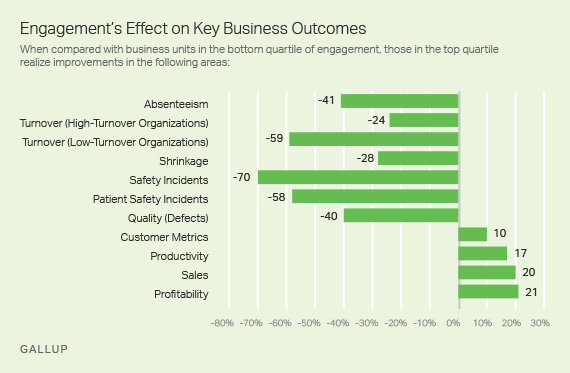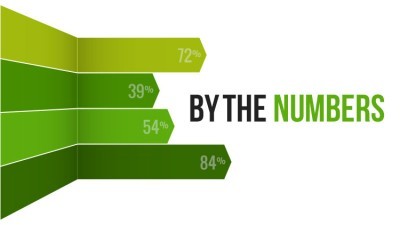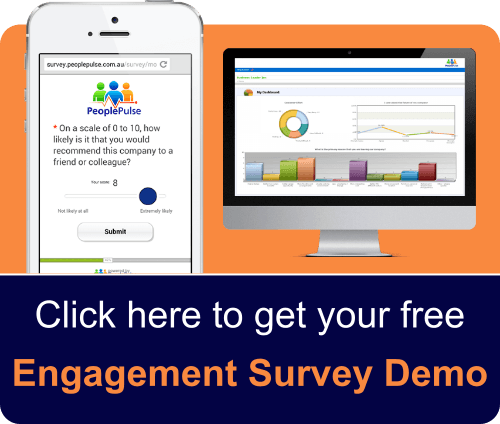Employee Engagement Surveys –
All You Need to Know
All You Need to Know

In This Resource Guide:
- What is Employee Engagement?
- How to Engage Employees: The Ten C’s of Engagement
- Employee Engagement and Higher Profits
- Measuring Employee Engagement
- A Few Tips for Asking the Right Questions
- Example Sections and Questions of the Employee Engagement Survey
- Key Staff Engagement Statistics
- Employee Engagement Infographic
What is Employee Engagement?
Employee Engagement is far more than just having a happy employee who is satisfied with their job. A number of employees in your organisation may seem content and enjoy being in the office, but are they truly engaged?
Employee engagement is an emotional commitment; it is the drive that an employee has to give it their all at work each day and put their best foot forward.
Engaged employees are motivated to work hard because they care about their work and strive to help their organisation reach its goals. They have a solid understanding of their role and how it ties in with the overall company objectives. They tend to be more customer centric, and take less time off of work.
Having a highly engaged workforce is crucial for the financial health of your organisation and can provide the following benefits:
- Increased Productivity
- Higher Employee Motivation
- Higher Customer Satisfaction
- Increased Sales
- Higher Profits
- Higher Shareholder Returns
How to Engage Employees: The Ten C’s of Engagement
The Ivey Business Journal provides a number of primary avenues for action on how to engage employees. Below is a list of the ten C’s of employee engagement:
- Connect: Leaders of the organisation must show that they value their staff.
- Career: Most people want to try new things in their job and have opportunities for career advancement. Leaders should provide their employees with challenging and meaningful work.
- Clarity: Employees want to see a clear vision for their organisation. Leaders should provide this vision and give their staff a clear understanding of what goals they want to achieve and how they will achieve them.
- Convey: Good leaders should establish processes and procedures that facilitate in goal achievement and mastering of important tasks. They also need to provide employees with feedback on their function within the organisation’s overall success.
- Congratulate: Based on a recent survey, many employees feel that they receive immediate feedback when performance is poor, and not enough praise when performance is high. A good leader should coach and convey while also providing a great deal of recognition.
- Contribute: Employees like to know that their efforts are contributing to the organisation’s success. A good leader helps their staff see and feel how their contributions are benefitting the company.
- Control: Employees like to have control over the pace and flow of their jobs. Leaders should implement a system that allows them to exercise this control and take ownership of their problems/solutions.
- Collaborate: A good leader is a team builder. Employees who have the trust and cooperation of their team members outperform individuals and teams that lack good relationships. Leaders should express the value of collaboration within the organisation.
- Credibility: Employees want to feel proud of their jobs and their organisation. Leaders need to maintain an organisation’s reputation and uphold high ethical standards.
- Confidence: A good leader will help create confidence in an organisation by demonstrating high ethical and performance standards.

Employee Engagement and Higher Profits
Based on numerous studies, it is clear that having engaged employees makes a big difference to the outputs and revenues of an organisation. When employees are truly engaged, they will be more productive and contribute greater to the success of a company.
A report from Gallup states that companies with a highly engaged workforce outperform their peers by 147% in earnings per share. Even more, when a company successfully engages both its staff and customers they experience a 240% boost in performance-related business outcomes.
Towers Perrin surveyed 600,000 employees from various industries in 2006. Based on their research, they found that during the period of study, companies with high levels of engagement improved 19.2% in operating income whereas companies with low levels of engagement declined 32.7%.
Concentrating on employee engagement can help companies withstand, and possibly even thrive, in tough economic times. – Gallup Research
Measuring Employee Engagement
Measuring your staff engagement levels is crucial. If you don’t know where your employees currently stand and take a baseline measure, how can you manage and improve these levels?
Employee Engagement Surveys are designed to measure and assess how motivated and engaged your employees are to perform their best at work each day. From these surveys, you can gain insight into employees’ thoughts and attitudes towards their work and the overall environment. You can also locate any areas that may be holding your employees back from performing at their best.
By taking action over time to improve your key engagement drivers, you will create a more effective and efficient workforce and a more profitable organisation.
Active disengagement costs between 450 billion and 550 billion per year in the US. Click To TweetA Few Tips for Asking the Right Questions
You want to gain all the actionable insights that you can from your staff engagement survey. You are putting the effort into running your survey, so make sure you are asking the good quality actionable questions while you’re at it. Below are a few tips to keep in mind when putting together a staff engagement survey:
- Keep your questions simple. If a survey question becomes too long and complicated, make it shorter by breaking it up into multiple questions. This will give your staff the ability to provide clearer answers and make analysing the data a lot easier.
- Have at least one open ended question on where improvements can be made. This gives your employees the chance to express their opinions regarding their work and the work environment overall.
- Ask more, tell less. The main point of running an employee engagement survey is to listen to what your employees have to say. Some questions may require further contextual explaining, however, this should be kept at a minimum to ensure the success of your survey.
- Try to organise your responses to be on a five point scale. Since a lot of the questions on your survey should have the ability to be answered with a ‘Strongly agree-Strongly disagree’ scale, be sure to keep this scale consistent throughout the survey. This allows for easier data analysis because you can directly compare scores for each question.
Example Sections and Questions of the Employee Engagement Survey
To keep your survey organised, you may consider breaking it up into sections that reflect the key drivers of engagement. This will not only help your employees provide clear, area-specific input, but also give you a finer understanding of which areas need improvement. Below is a list of common sections you may find on an employee engagement survey, with a few example questions to help get you started (NB: PeoplePulse clients will receive access to our full master Engagement Question library):
- Demographics
- Age, Gender, Location, Division, Department, Tenure
- Leadership (example questions):
- Leadership clearly communicates the organisations goals and values.
- I have confidence in the senior management of this organisation.
- Planning (example questions):
- There is adequate planning of corporate objectives.
- The senior management level in my organisation provides clear direction and guidelines for the future.
- Your manager (example questions):
- I receive the support I need to succeed from my manager.
- My manager recognises my efforts.
- Your job (example questions):
- I have a clear understanding of my job role.
- I understand the importance of my role to the success of the organisation.
- Job Satisfaction (example questions):
- I like the type of work that I do.
- I feel that I am valued in this organisation.
- Workplace Culture (example questions):
- There is a good level of positive energy shown by other staff members.
- This organisation cares about delivering a quality outcome to our customers.
- Communication (example questions):
- Information is freely shared across teams and departments.
- Information flows quickly through the organisation.
- Motivation, Commitment, Empowerment (example questions):
- I feel a strong sense of belonging to my organisation.
- This organisation motivates me to contribute more than is normally required in my work.
- Your Team (example questions):
- The people I work with have strong skills and abilities.
- There is good sharing of knowledge amongst the people I work with
- Training and Career Development (example questions):
- I receive the support I need to achieve my career goal.
- I have access to training programs to help me achieve optimal results.
- Recognition and Rewards (example questions):
- I am fairly compensated for the work I do.
- Considering all my efforts and achievements at work, I feel I am fairly rewarded.
- Resources, Technology, and the Work Environment (example questions):
- I have access to the information I need to perform my best.
- At my work place, the physical environment is appropriate for the type of work I do.
- Work/Life Balance (example questions):
- My work arrangements are flexible.
- I am able to maintain an appropriate and healthy balance between my work and my personal commitments.
- Diversity and Inclusion/Equal Opportunity (example questions):
- I am treated with fairness and respect in this organisation.
- I would feel able to report bullying/harassment without worrying that it would have a negative impact on me.
- Final Thoughts (example questions):
- Open ended question: Overall, what do you like most about working here?
- Open ended question: What do you like least about working here?

Key Staff Engagement Statistics:
- 87% of employees worldwide are not engaged at work, and companies with highly engaged work forces outperform their peers by 147% in earnings per share. (Analytics and Tools to Transform Your Workplace, Gallup)
- Employee Engagement has become the top issue on the minds of business leaders, directing us to an entirely new model of management. (7 Fascinating Employee Engagement Trends for 2016, 15 Five)
- Active disengagement costs between 450 billion and 550 billion per year in the US, based on the 2013 Gallup report.
- 70% of engaged employees say they have a good understanding of how to meet customer needs, while only 17% of non-engaged employees say the same. (How Engagement Affects Company Profit and Performance, HuffPost)
- Based on surveys of over 600,000 staff members in a wide range of industries, companies with high levels of employee engagement improved 19.2% in operating income while companies with low levels of engagement declined 32.7% during the period of study. (How Engagement Affects Company Profit and Performance, HuffPost)
- 84% of highly engaged employees believe they can positively impact the quality of their organisations products, compared to only 31% of disengaged. 72% of highly engaged employees believe they can positively affect customer service, compared to only 27% of the disengaged. 68% of highly engaged employees believe they can positively impact costs in their job or unit, compared to just 19% of the disengaged. (What Engages Employees the Most OR, the Ten C’s of Employee Engagement, Ivey Business Journal)
Employee Engagement Infographic:

Get a Live Demo:
Get a free demo of our Employee Engagement Survey Software & Reporting Console in action. Simply complete the from below and we’ll be in touch shortly:
Further Reading:
PeoplePulse – our Staff Engagement Survey Solution
A Complete Guide to Staff Pulse Surveys – Your ultimate resource covering what Staff Pulse Surveys are, why they should be used, incl. advantages, disadvantages, tips, statistics, and how to use them successfully.
Article Sources:
Understanding What Drives Employee Engagement, Towers Perrin 2003
The 9 Questions that Should be in Every Employee Engagement Survey, CEB 2016
How Employee Engagement Drives Growth, Gallup 2013
How Engagement Affects Company Profit and Performance, Huffington Post 2016
What is Employee Engagement, Forbes 2012
What Engages Employees the Most OR, the Ten Cs of Employee Engagement, Ivey Business Journal 2006



 Exceptional Survey. Solutions
Exceptional Survey. Solutions